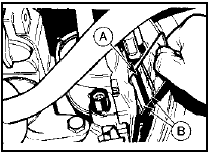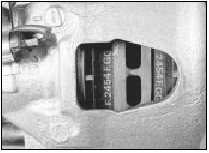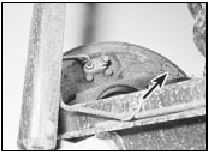Front and rear brake pad/shoe check (Every 6000 miles (10 000 km) or 6 months)
1 Firmly apply the handbrake, then jack up the front and rear of the car and support it securely on axle stands (see “Jacking and vehicle support”).
2 For a quick check, the front brake disc pads can be inspected without removing the front wheels by inserting a mirror between each caliper and roadwheel (see illustration). If any one pad is worn down to the minimum specified thickness, all four pads (on both front wheels) must be renewed.

9.2 Using a mirror to inspect the disc pad friction material for wear
A Brake disc B Brake disc pads
3 It is necessary to remove the rear wheels in order to inspect the rear disc pads. The pads can be viewed through the top of the caliper after removing the blanking spring clip (see illustration). If any one pad is worn down to the minimum specified, all four pads (on both rear wheels) must be renewed.

9.3 Disc pads viewed through caliper inspection hole (roadwheel removed)
4 For a comprehensive check, the brake disc pads should be removed and cleaned. The operation of the caliper can then also be checked, and the condition of the brake discs can be fully examined on both sides. Refer to Chapter 10 for further information.
5 On rear drum brake models, the brake shoe friction material can be inspected for wear without removing the roadwheels. Working beneath the vehicle, prise the plug from the brake backplate, and using an inspection lamp or torch, check that the friction material thickness is not less than the minimum given in the Specifications (see illustration). If any one of the shoes has worn below the specified limit, the shoes must be renewed as an axle set (4 shoes).

9.5 Brake shoe inspection hole plug (arrowed)
6 At the same interval, check the function of the brake fluid level warning light. Chock the wheels, release the handbrake and switch on the ignition. Unscrew and raise the brake fluid reservoir cap whilst an assistant observes the warning light: it should come on as the level sensor is withdrawn from the fluid. Refit the cap.
7 On completion, refit the wheels and lower the car to the ground.
See also:
Engine oil and filter renewal (Every 6000 miles (10 000 km) or 6 months)
1 Frequent oil and filter changes are the most
important preventative maintenance
procedures which can be undertaken by the
DIY owner. As engine oil ages, it becomes
diluted and contaminated, whic ...
General Repair Procedures
Whenever servicing, repair or overhaul work
is carried out on the car or its components, it
is necessary to observe the following
procedures and instructions. This will assist in
carrying out the ...
Engine/automatic transmission assembly - reconnection and refitting
1 Reverse the procedure described in
paragraphs 1 to 25 of Section 8, noting the
following points.
2 Check that the engine adapter plate is
correctly positioned on its locating dowels. If
necessa ...
